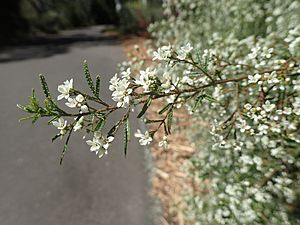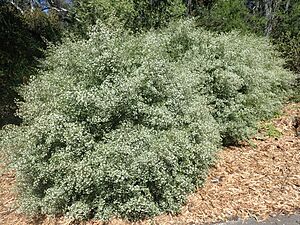Wollumbin zieria facts for kids
Quick facts for kids Wollumbin zieria |
|
|---|---|
 |
|
| Zieria adenodonta leaves and flowers | |
| Scientific classification | |
| Genus: |
Zieria
|
| Species: |
adenodonta
|
The Wollumbin zieria (scientific name: Zieria adenodonta) is a special plant. It belongs to the citrus family called Rutaceae. This plant is found only in eastern Australia, which means it is endemic there. It grows as a thick, bushy shrub. Its leaves are made of three smaller parts called leaflets, and the top surface feels a bit bumpy. In winter and early spring, this plant shows off groups of five to eight white flowers. Each flower has four white petals. These flower groups are usually shorter than the leaves.
Contents
What Does Wollumbin Zieria Look Like?
The Wollumbin zieria is a dense, bushy shrub. It can grow up to about 3 meters (10 feet) tall. Its small branches are also warty, meaning they have small bumps.
The leaves are made of three separate leaflets. The middle leaflet is usually 10 to 20 millimeters (about 0.4 to 0.8 inches) long. It is also 1.5 to 3 millimeters (about 0.06 to 0.12 inches) wide. The stalk that holds the leaflets is 3 to 7 millimeters (about 0.1 to 0.3 inches) long. The top of the leaflets is dark green and bumpy. The bottom side is light green and smooth. The edges of the leaflets are slightly curled under. They also have tiny teeth. If you crush the leaves, they have a strong, unpleasant smell.
The flowers of the Wollumbin zieria are white. They grow in the upper leaf axils, which are the spots where leaves meet the stem. Usually, there are five to eight flowers in a group. Sometimes, there can be as many as 27 flowers. These flower groups are generally shorter than the leaves.
Each flower has four small, triangular parts called sepal lobes. These are less than 1.0 millimeter (about 0.04 inches) long and are a bit hairy. The four white petals are about 2.5 millimeters (about 0.1 inches) long. They are also slightly hairy. Like other zieria plants, this one has only four stamens.
The plant flowers from May to September. After flowering, it produces a fruit. This fruit is a yellow-brown, egg-shaped capsule. Inside the capsule, there is one black seed.

How It Got Its Name
The History of Its Name
The Wollumbin zieria was first officially described in 1875. A scientist named Ferdinand von Mueller gave it a long name: Zieria granulata var. adenodonta. He wrote about it in a book called Fragmenta phytographiae Australiae.
Later, in 2002, another scientist named James Armstrong changed its status. He decided it was a full species on its own. He published this change in a scientific paper called Australian Systematic Botany.
What Does "Adenodonta" Mean?
The second part of its scientific name, adenodonta, comes from two Ancient Greek words. The word aden means "gland". The word odous means "tooth". This name likely refers to the small, tooth-like bumps or glands on the plant's leaves or branches.
Where Wollumbin Zieria Lives
The Zieria adenodonta grows in specific places. You can find it in the Lamington National Park in Queensland. It also grows on Mount Warning in New South Wales. This plant likes to grow in thick, bushy areas on steep hillsides.
Protecting This Plant
The Wollumbin zieria is a very important plant. It is listed as "Endangered" under the New South Wales NSW Threatened Species Conservation Act. This means there are not many of these plants left in the wild. It is very important to protect them so they do not disappear forever.

